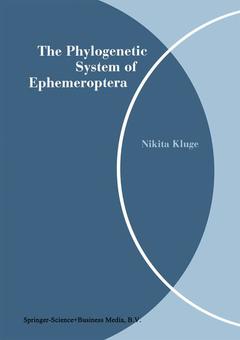Description
The Phylogenetic System of Ephemeroptera, 2004
Author: Kluge Nikita
Language: English
Subjects for The Phylogenetic System of Ephemeroptera:
Keywords
Meere; classification; entomology; insect; morphology; phylogeny; Model invertebrates
The Phylogenetic System of Ephemeroptera
Publication date: 04-2014
442 p. · 21x29.7 cm · Paperback
Publication date: 04-2014
442 p. · 21x29.7 cm · Paperback
The phylogenetic system of Ephemeroptera
Publication date: 03-2004
442 p. · 21x29.7 cm · Hardback
Publication date: 03-2004
442 p. · 21x29.7 cm · Hardback
Description
/li>Comment
/li>
This volume contains new data which are interesting : for entomologists and hydrobiologists interested in systematics and phylogeny of mayflies, for entomologists and zoologists interested in phylogeny and general morphology of insects, for biologists interested in elaboration of effective methods of phylogeny reconstruction and rational presentation of taxonomical information. Mayfly researchers will find in this book the most comprehensive account of characters of all hierarchically subordinated mayfly taxa higher than species (except for subordinated taxa of Baetidae s.str. and Leptophlebiidae). All taxa characteristics are supplied with cross-references and references to a general Index of Characters, which allows the reader to clarify the pattern of each character independently, whether or not it agrees with the author's phylogenetic hypothesis. The book contains complete lists of formal species names of mayflies of the world (except for Baetidae s.str. and Leptophlebiidae), with recent conclusion about status and systematic position of each. People interested in general entomology will find in the General Part of this book a new interpretation of insect abdominal structure and other data on general insect morphology, as well as a revised account of peculiarities of Ephemeroptera. These data were partly previously published only in Russian, and partly are published here for the first time. The book has general biological significance due to usage of the new non-ranking nomenclature and the rational layout of taxonomic text, which can be qualified as post-Linnaean systematics. While after the works by Lameere and Hennig, non-ranking classifications became widely used, this book represents the first experience of consistently non-ranking classification, including taxa of low taxonomic level (i.e. taxa traditionally regarded as genera, families et al.). In contrast to other recent attempts to elaborate a non-ranking nomenclature not contradictory to the International Code of Zoological Nomenclature, this one appears to be successful and can be applied to any zoological taxa (although its application in botany could be possible only after further elaboration). Biology is currently going through a crisis, which causes some investigators to use such non-scientific methods of reconstructing phylogeny as parsimony analysis. The author believes that the new method of phylogeny description and reconstruction used in this book will help indicate a way out of this crisis.
From the reviews:"This volume by Nikita Kluge of the St. Petersburg State University, Russia, has been one of the most anticipated among ephemeropterists ... . is an important milestone in Ephemeroptera phylogeny and should be mandatory reading for everyone interested in mayfly systematics. It is mainly an enumeration of the putative apomorphic characters of fossil and extant mayfly taxa, mostly accompanied by excellent line-drawings, which are very informative. However in my opinion, Kluge's nomenclature is ... used as a tool by scientists for communicating with one another." (T. Soldan, European Journal of Entomology, Vol. 104, 2007)
© 2024 LAVOISIER S.A.S.




